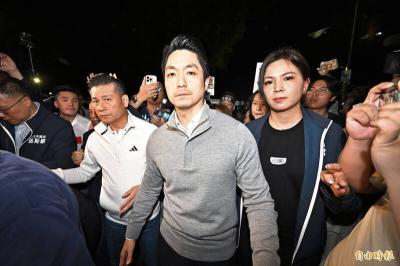After eight months of research, Taiwanese raptor experts recently completed tracing the migration pattern of the endangered gray-faced buzzard, an Asian bird of prey, the Forestry Bureau said on Thursday.
A research study sponsored by the bureau shows that gray-faced buzzards, or Butastur indicus, stop over in Taiwan every October on their way south to winter in southern areas of the Philippines.
The raptors then fly north in the spring, making another stop in Taiwan before continuing their migration to the China-Russia border near China's Heilongjiang Province or North Korea to breed, the findings show.

PHOTO: CNA
Between 15,000 and 35,000 gray-faced buzzards visit Taiwan during these spectacular migrations, but prior to the latest study, knowledge of where the birds came from and where they went was scant.
Keen to find out more about the birds' migration patterns, the research team, including researchers from Academia Sinica and the non-profit Raptor Research Group of Taiwan, fitted satellite trackers on several adult buzzards to find out more about their habits.
The findings solved part of an old puzzle surrounding the birds, said Lin Wen-hung (林文宏), the secretary-general of the Raptor Research Group of Taiwan.
“The migration pattern that we have discovered, however, does not mean that all gray-faced buzzards use the same route for their annual migrations,” Lin said.
The gray-faced buzzard is listed in Appendix II of the Convention on International Trade in Endangered Species of Wild Flora and Fauna (CITES) and is also protected by inclusion as a Rare and Valuable Species under Taiwan's Wildlife Conservation Act, the Forestry Bureau said.
Generally, the southern migration areas of gray-faced buzzards are limited to Southeast Asia. In summer, they breed in eastern areas of Asia, including northern China, the Korean peninsula, an area southeast of the River Ussuri in Russia and Japan. When autumn comes, they migrate south to southeastern China, Indochina, the Philippines, Borneo, the Celebes and New Guinea, although the migration routes are still not clear.
Japanese researchers were the first to carry out a satellite positioning plan for tracing the buzzards. They marked and released several of the raptors from the Japanese island of Ishigaki, hoping that they would fly south — the birds headed north instead.
Last October, the Taiwanese team fitted satellite trackers to five adult gray-faced buzzards caught in Kenting National Park and the Mt Bagua National Scenic Area in Changhua County.
The five birds were dubbed Cape Nos. 1 to 5 and then released. The researchers lost contact with Cape No. 3 and No. 4 somewhere over the ocean as the birds were flying north and their transmitters remained silent, the bureau said.
The other three — Cape No. 1, No. 2 and No. 5 — continued transmitting signals, showing the precise locations of their travel routes and unveiling their hitherto mysterious migration routes.
Cape No. 1 was found to have traveled more than 9,000km in a broad circle covering the southern Philippines at the southernmost location and Heilongjiang Province at the northernmost tip, with Taiwan as a midway stop and a mountainous area in China's northeastern Jilin Province as its breeding ground early last month, bureau officials said.
The bird took refuge on a tiny island off China's Guangdong Province in March under the strong northeast monsoon, where it recovered its strength before heading further north around the end of May.
Cape No. 2 and No. 5 also flew more than 9,000km in a migration circle, breeding in a rural area of North Korea.
The recent finding — the first migration data on gray-faced buzzards — has set up a good scientific foundation for further migration research, the officials said.
“Further and more detailed research will help us find out more about the birds,” Lin said.

Several Chinese Nationalist Party (KMT) officials including Chairman Eric Chu (朱立倫) are to be summoned for questioning and then transferred to prosecutors for holding an illegal assembly in Taipei last night, the Taipei Police said today. Chu and two others hosted an illegal assembly and are to be requested to explain their actions, the Taipei City Police Department's Zhongzheng (中正) First Precinct said, referring to a protest held after Huang Lu Chin-ju (黃呂錦茹), KMT Taipei's chapter director, and several other KMT staffers were questioned for alleged signature forgery in recall petitions against Democratic Progressive Party (DPP) legislators. Taipei prosecutors had filed

Taiwan would welcome the return of Honduras as a diplomatic ally if its next president decides to make such a move, Minister of Foreign Affairs Lin Chia-lung (林佳龍) said yesterday. “Of course, we would welcome Honduras if they want to restore diplomatic ties with Taiwan after their elections,” Lin said at a meeting of the legislature’s Foreign Affairs and National Defense Committee, when asked to comment on statements made by two of the three Honduran presidential candidates during the presidential campaign in the Central American country. Taiwan is paying close attention to the region as a whole in the wake of a

President William Lai (賴清德) has appointed former vice president Chen Chien-jen (陳建仁) to attend the late Pope Francis’ funeral at the Vatican City on Saturday on his behalf, the Ministry of Foreign Affairs said today. The Holy See announced Francis’ funeral would take place on Saturday at 10am in St Peter’s Square. The ministry expressed condolences over Francis’ passing and said that Chen would represent Taiwan at the funeral and offer condolences in person. Taiwan and the Vatican have a long-standing and close diplomatic relationship, the ministry said. Both sides agreed to have Chen represent Taiwan at the funeral, given his Catholic identity and

Lawmakers from the Democratic Progressive Party (DPP) yesterday established a friendship group with their counterparts in Ukraine to promote parliamentary exchanges between the two countries. A ceremony in Taipei for the Taiwan-Ukraine Parliamentary Friendship Association, initiated by DPP Legislator Chen Kuan-ting (陳冠廷), was attended by lawmakers and officials, including Deputy Minister of Foreign Affairs Francois Wu (吳志中) and European Economic and Trade Office in Taiwan Director Lutz Gullner. The increasingly dire situation in Ukraine is a global concern, and Taiwan cannot turn its back when the latter is in need of help, as the two countries share many common values and interests,